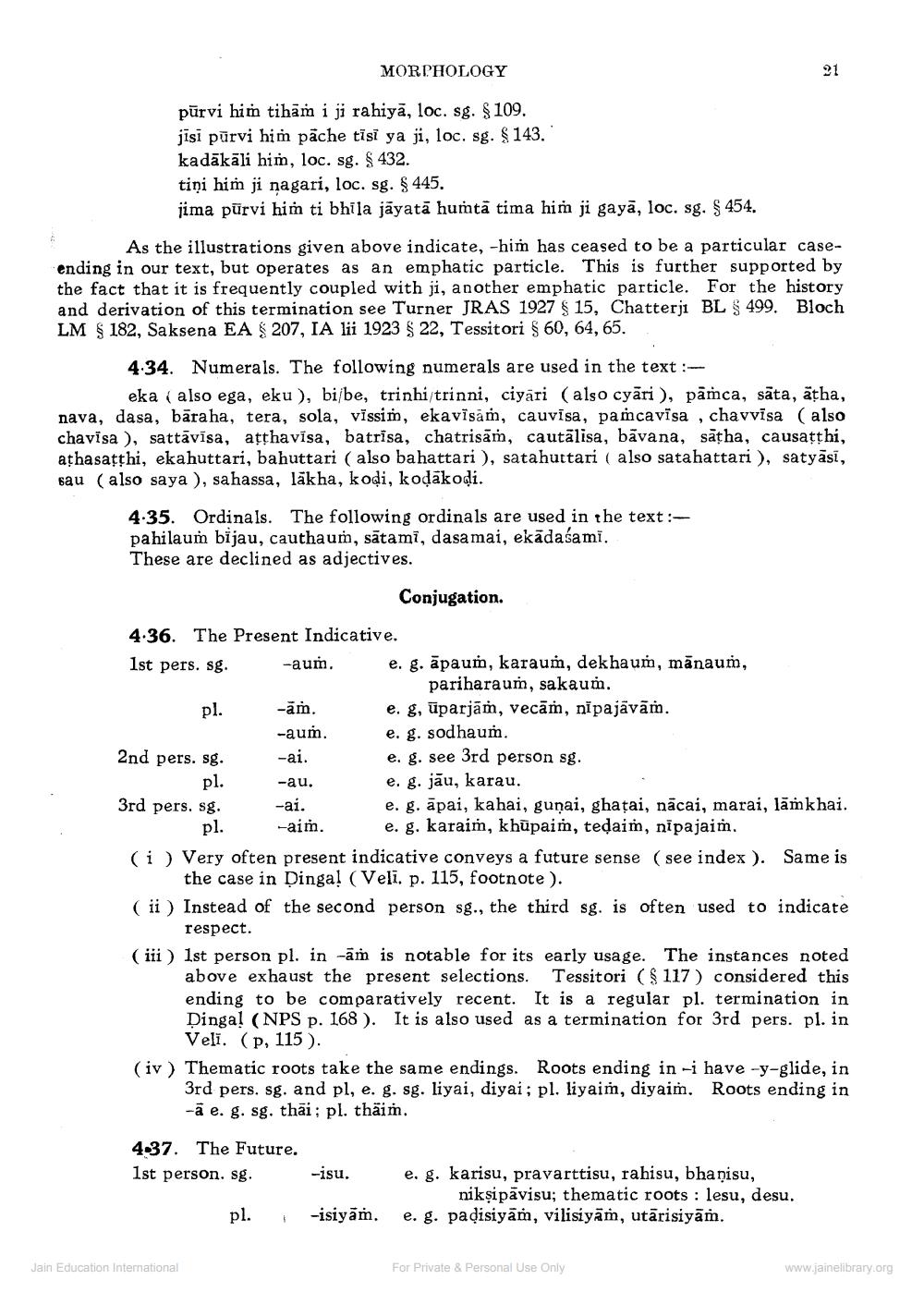________________
MORPHOLOGY
purvi him tiham i ji rahiya, loc. sg. $109.
jisi purvi him päche tisi ya ji, loc. sg. §143.
kadākāli him, loc. sg. § 432.
tini him ji nagari, loc. sg. § 445.
jima purvi him ti bhīla jāyatā humta tima him ji gaya, loc. sg. § 454.
As the illustrations given above indicate, -him has ceased to be a particular caseending in our text, but operates as an emphatic particle. This is further supported by the fact that it is frequently coupled with ji, another emphatic particle. For the history. and derivation of this termination see Turner JRAS 1927 § 15, Chatterji BL § 499. Bloch LM 182, Saksena EA $207, IA li 1923 § 22, Tessitori § 60, 64, 65.
4.34. Numerals. The following numerals are used in the text :
eka also ega, eku), bijbe, trinhi trinni, ciyari (also cyari), päṁca, sata, atha, nava, dasa, bāraha, tera, sola, vissim, ekavisām, cauvisa, pamcavisa, chavvisa (also chavisa), sattāvisa, atthavisa, batrisa, chatrisam, cautalisa, bāvana, satha, causatthi, athasatthi, ekahuttari, bahuttari (also bahattari ), satahuttari (also satahattari), satyasi, sau (also saya), sahassa, läkha, kodi, kodakodi.
4.35. Ordinals. The following ordinals are used in the text:pahilaum bijau, cauthaum, sätami, dasamai, ekādasami. These are declined as adjectives.
4.36. The Present Indicative.
1st pers. sg.
pl.
2nd pers. sg.
pl.
3rd pers. sg.
pl.
-aum.
-ām.
-aum.
-ai.
-au.
-ai.
-aim.
Jain Education International
Conjugation.
(i) Very often present indicative conveys a future sense (see index). Same is the case in Dinga! (Veli. p. 115, footnote).
4.37. The Future.
1st person. sg.
pl.
e. g. apaum, karaum, dekhaum, mānaum, pariharaum, sakaum.
e. g, uparjam, vecām, nipajāvām.
e. g. sodhaum.
e. g. see 3rd person sg.
e. g. jau, karau.
(ii) Instead of the second person sg., the third sg. is often used to indicate
respect.
21
(iii) 1st person pl. in -am is notable for its
early usage. The instances noted above exhaust the present selections. Tessitori (§ 117) considered this ending to be comparatively recent. It is a regular pl. termination in Dingal (NPS p. 168). It is also used as a termination for 3rd pers. pl. in Veli. (p. 115).
-isu.
e. g. apai, kahai, gunai, ghatai, näcai, marai, läṁkhai. e. g. karaim, khüpaim, tedaim, nipajaim.
(iv) Thematic roots take the same endings. Roots ending in -i have -y-glide, in 3rd pers. sg. and pl, e. g. sg. liyai, diyai; pl. liyaim, diyaim, Roots ending in -a e. g. sg. thai; pl. thaim.
-isiyam.
e. g. karisu, pravarttisu, rahisu, bhanisu, nikṣipāvisu; thematic roots: lesu, desu. e. g. padisiyam, vilisiyām, utarisiyām.
For Private & Personal Use Only
www.jainelibrary.org




